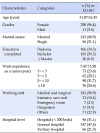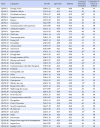Abstract
Purpose
The aim of this study was to test the validity and reliability of the Korean version of the Quality of Nursing Work Life (QNWL-K) scale. The scale measures the reported quality of the nurse' work life among Korean nurses.
Methods
The QNWL-K was developed through forward-backward translation techniques. An internal consistency reliability and construct validity using exploratory analysis were conducted using SPSS/WIN (21.0). Survey data were collected from 309 nurses who worked in two tertiary hospitals, four general hospitals, and two hospitals in Seoul and Gyeonggi, South Korea.
Results
Factor analysis results of the revised QWNL-K demonstrated that it has a four-factor structure (work context, support systems for home/work life, work design, and staffing) that supports construct validity. Factor loadings of the 36 items ranged from .30~.77. The QNWL-K showed reliable internal consistency from Cronbach's α for the total scale of .93.
Figures and Tables
References
1. Joung MS, Kim KJ. A study on the effect of emotional labor and leader's emotional intelligence on job satisfaction and organizational commitment for nurses. Korean J Hosp Manag. 2006; 11(4):1–18.
2. Fujimoto T, Kotani S, Suzuki R. Work-family conflict of nurses in Japan. J Clin Nurs. 2008; 17(24):3286–3295. DOI: 10.1111/j.1365-2702.2008.02643.x.

3. Park KO, Kim SY, Kim JK. Hospital nurses' experience of bullying in the workplace and burnout, organizational commitment, turnover intention and nursing productivity. J Korean Clin Nurs Res. 2013; 19(2):169–180.
4. Mosadeghrad AM, Ferlie E, Rosenberg D. A study of relationship between job stress, quality of working life and turnover intention among hospital employees. Health Serv Manage Res. 2011; 24(4):170–181. DOI: 10.1258/hsmr.2011.011009.

5. Sirgy MJ, Reilly NP, Wu J, Efraty D. A work-life identity model of well-being: towards a research agenda linking quality-ofwork-life (QWL) programs with quality of life (QOL). Appl Res Qual Life. 2008; 3(3):181–202. DOI: 10.1007/s11482-008-9054-6.

6. Brooks BA, Storfjell J, Omoike O, Ohlson S, Stemler I, Shaver J, et al. Assessing the quality of nursing work life. Nurs Adm Q. 2007; 31(2):152–157. DOI: 10.1097/01.NAQ.0000264864.94958.8e.

7. Gurses AP, Carayon P, Wall M. Impact of performance obstacles on intensive care nurses' workload, perceived quality and safety of care, and quality of working life. Health Serv Res. 2009; 44:422–443. DOI: 10.1111/j.1475-6773.2008.00934.x.

8. Brooks BA, Anderson MA. Defining quality of nursing work life. Nurs Econ. 2005; 23(6):319–326.
9. O'Brien-Pallas L, Baumann A. Quality of nursing work life issues-a unifying framework. Can J Nurs Adm. 1992; 5(2):12–16.
10. Mohamad M, Mohamad WN. A model of quality of work life, life satisfaction and service quality. Asian J Bus Res. 2012; 2(2):38–51. DOI: 10.14707/ajbr.120009.

11. Brooks BA. Development of an instrument to measure quality of nursing work life [dissertation]. Chicago: University of Illinois;2001.
12. Kim MJ, Ryu EJ. Structural equation modeling of quality of work life in clinical nurses based on the Culture-Work-Health Model. J Korean Acad Nurs. 2015; 45(6):879–889. DOI: 10.4040/jkan.2015.45.6.879.

13. Fu X, Xu J, Song L, Li H, Wang J, Wu X, et al. Validation of the Chinese version of the quality of nursing work life scale. PLoS One. 2015; 10(5):e0121150. DOI: 10.1371/journal.pone.0121150.

14. Lee YW, Dai YT, McCreary LL, Yao G, Brooks BA. Psychometric properties of the Chinese version quality of nursing work life scale. Nurs Health Sci. 2014; 16(3):298–306. DOI: 10.1111/nhs.12099.
15. McCloskey JC, McCain BE. Satisfaction, commitment and professionalism of newly employed nurses. Image J Nurs Sch. 1987; 19(1):20–24.

16. Tabachnick BG, Fidell LS. Using multivariate statistics. 5th ed. Boston, MA: Pearson/Allyn & Bacon;2013. p. 644–646.
17. Brooks BA, Anderson MA. Nursing work life in acute care. J Nurs Care Qual. 2004; 19(3):269–275. DOI: 10.1097/00001786-200407000-00014.

18. World Health Organization. (n.d.). Process of translation and adaptation of instruments [internet]. Geneva: WHO;2016. cited 2015 May 15. Available from: http://www.who.int/substance_abuse/research_tools/translation/en/.
19. Lynn MR. Determination and quantification of content validity. Nurs Res. 1986; 35:382–385. DOI: 10.1097/00006199-198611000-00017.

20. Lee CY. Advanced nursing statistics. 1st ed. Seoul: Soomoonsa;2016. p. 189–196.
21. Field A. Discovering statistics using SPSS. 3rd ed. London: Sage Publications;2009. p. 167–196.
22. Um MY, Cho SW. Scale development in social work practice. Seoul: Hakjisa;2005. p. 97–108.
23. Henson RK, Roberts JK. Use of exploratory factor analysis in published research common errors and some comment on improved practice. Educ Psychol Meas. 2006; 66(3):393–416. DOI: 10.1177/0013164405282485.
24. Lee EO, Lim NY, Park HA, Lee IS, Kim JI, Bae JI, et al. Nurs Res Stat. Paju: Soomoonsa;2009. p. 197–205.
25. Terwee CB, Mokkink LB, Knol DL, Ostelo RW, Bouter LM, de Vet HC. Rating the methodological quality in systematic reviews of studies on measurement properties: a scoring system for the COSMIN checklist. Qual Life Res. 2012; 21(4):651–657. DOI: 10.1007/s11136-011-9960-1.

26. Sirin M, Sokmen SM. Quality of nursing work life scale: the psychometric evaluation of the Turkish version. Int J Caring Sci. 2015; 8(3):543–554.
27. Lee JM, Bae DH, Woo JM. Revision of the mental fitness scale: validation and confirmatory factor analysis. J Korean Neuropsychiatr Assoc. 2013; 52(6):431–441. DOI: 10.4306/jknpa.2013.52.6.431.
28. Kim MJ. Structuring equation modeling of quality of work life in clinical nurse based on the culture-work-health model [dissertation]. Seoul: Chung Ang University;2015.
29. Nannally JC. Psychometric theory. 2nd ed. New York: McGrow-Hill;1978. p. 195.
30. Alalki MJ, FitzGerald G, Clark M. Quality of work life among primary health care nurses in the Jazan region, Saudi Arabia: a cross-sectional study. Hum Resour Health. 2012; 10(1):1–13. DOI: 10.1186/1478-4491-10-30.





 PDF
PDF ePub
ePub Citation
Citation Print
Print






 XML Download
XML Download